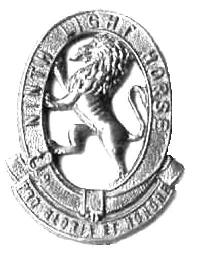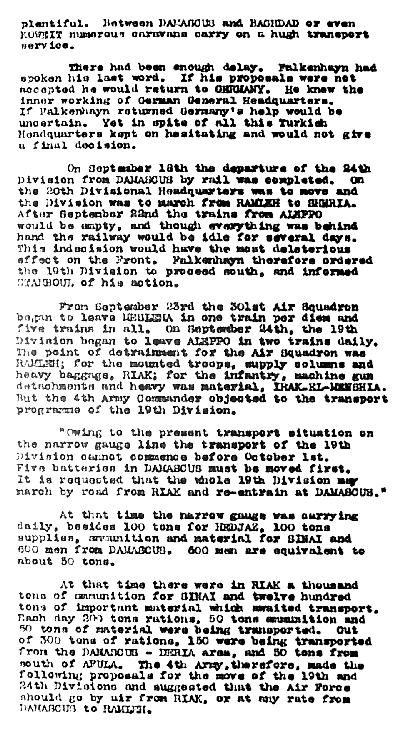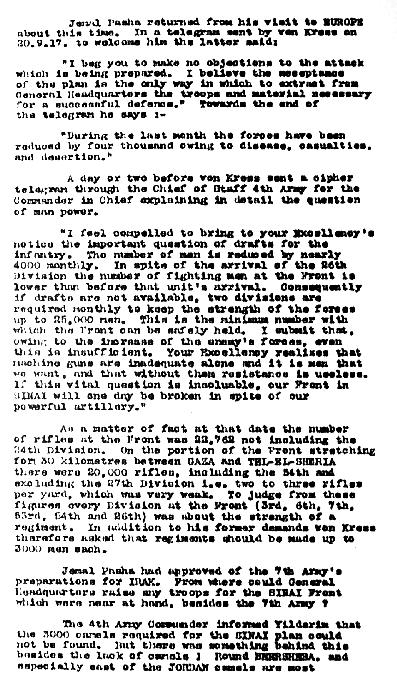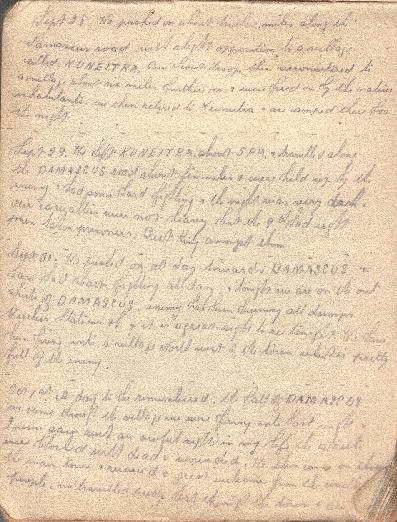Topic: AIF - 3B - 9 LHR
9th LHR, AIF
War Diary, 1 October

Pro Gloria et Honore - For Glory and Honour
Regimental March - Marching Through Georgia
The Diary
1914
Thursday, October 1, 1914
Formation of the 7th Light Horse Regiment "B" Squadron at Morphettville Race Course, South Australia.
1915
Friday, October 1, 1915
9th Light Horse Regiment Location - Rhododendron Hill
9th Light Horse Regiment War Diary - Second Lieutenant Dean AE went to hospital.
1916
Sunday, October 1, 1916
9th Light Horse Regiment Location - Bir el Abd
9th Light Horse Regiment War Diary - Routine
1917
Monday, October 1, 1917
9th Light Horse Regiment Location - Um Urgan
9th Light Horse Regiment War Diary - Brigade Operation Order Number 44 received. Intention - The Australian Mounted Division will cover a reconnaissance on Tuesday 2 October 1917 by taking up the line Goz Sheihili - Ibn Saiid - 960 - 970 - 840 - 320 - 770 - 750 - 630 - 550 - 510 to be made good by 1400. Units of this Brigade to hold the following sections - 10th Light Horse Regiment Point 910, Goz Sheihili to Point 940 Ibn Saiid to 960 inclusive. 8th Light Horse Regiment 960 exclusive to 970 to 840 exclusive. 9th Light Horse Regiment to serve as reserve. Regimental Order Number 60 issued to Squadrons.
1918
Tuesday, October 1, 1918
9th Light Horse Regiment Location - Dumar; Damascus; Marista el Basal; Khan Ayash
9th Light Horse Regiment War Diary - 0500 The Regiment joined remainder of 3rd Light Horse Brigade crossed the Barada by bridge at Dumar thence proceeded along main road towards Damascus. The road was strewn with enemy dead and wounded and in places dead animals and abandoned transport and guns, almost completely blocked the roadway. The road for about a mile presented a horrible sight amidst such charming surroundings. The devastating effect of accurate machine gun and rifle fire was everywhere apparent. Many of the vehicles had overturned into the Barada River. About one thousand prisoners were collected in the vicinity of Dumar railway station. A complete train was taken between Dumar and Damascus side of gorge. A few Germans made a slight stand here but were soon overpowered by advanced Regiment [10th Light Horse Regiment.]
The Brigade continued to advance along main road towards Damascus unopposed entering the city near the Victoria Hotel at about 0700 Large crowds of enthusiastic inhabitants lined the streets offering gifts of fruit, cigarettes etc and at several places residents from the upper stories of shops and houses sprinkled scent on to our troops passing along the roadway below. This part of the operation was more like a triumphal march and quite a new experience to most of our troops. The Brigade continued to push on through the narrow bazaar alleyways between Salaniys and Amara until the main Aleppo Road was reached. The Brigade then advanced north east along main Aleppo Road. Horses were watered near Jobar and a halt made for half an hour, then the advance continued. The advanced Regiment gained contact with enemy rearguard in vicinity of Marista el Basal. 9th Light Horse Regiment trotted forward in close support.
1300 B and C Squadrons less heavy packs were placed on either flank of the 10th Light Horse Regiment and half an hour later A Squadron less heavy packs moved to left flank of 10th Light Horse Regiment. Information now received that a large force of enemy with a strong rearguard were retreating north east along main Aleppo Road.Daly, Major TJ, with Regimental Headquarters moved to the left flank and pushed forward rapidly to within one mile south west of Khan Ayash and with C Squadron at Khan Ayash. 10th Light Horse Regiment were astride the main road 11/2 miles south west Khan Ayash with advanced troops at Khan Ayash. The enemy were now moving up the pass leading into the hills just north of Khurbet i Asafur thus securing their retreat.
1800 The Regiment less A Squadron concentrated on main road two miles south west Khan Ayash and withdrew to bivouac at Khan Kusseir, A Squadron rejoining en route. Hogan, Lieutenant LR; and, ten Other Ranks mounted as night outpost near the Khan at Khan Kusseir. Scott, Lieutenant Colonel WH, rejoined Regiment. Following members of 9th Light Horse Regiment taken prisoner of war 29/9/18 now reported to be in hospital Damascus: - King, 552 Sergeant AE; Betteridge, 226 Corporal AL; Down, 921 Corporal AC; Clark, 1528 Lance Corporal GB; Hanrahan, 2116 Lance Corporal EP; O'Donnell, 2148 Trooper DB; and, Adams, 702 Corporal MG.
3rd Light Horse Brigade War Diary - The situation in Damascus at this time, it was afterwards ascertained, was as follows: Djemal Pasha, Commander of the Turkish 4th Army arranged to hold a meeting of the Notables of Damascus at the Municipal Gardens at 4, p.m., on 30th September, 1918 for the purpose of handing over to Shukri Pasha Ayoubi the Military Governorship of the City. The last mentioned person was an Arab, formerly in the Turkish army and favourable to the Sheriff of Mecca. There was in the city at this time a person of Algerian birth named Emir Said. This man had been for some time past employed by the Turkish Government in raising a volunteer force of Arabs to fight against the Sheriff. Emir Said's sympathies were really in favour of the Sheriff, but he had disguised the fact and drew arms, and ammunition and money from the Turks.
Some time prior to 2 p.m. on the 30th September 1918, news was received in the city that the British Cavalry were approaching. A report was also circulated in the city that the Germans intended to burn the city before they left. Shukri Pasha Ayoubi and Emir Said then went to Djemal Pasha and informed him that they would not allow the city to be burned and advised Djemal Pasha to leave the city forthwith and stated that if he would not, he would be attacked by the local Arabs.
In Djemal Pasha's presence these produced the Sheriff's flag displayed it on the Town Hall, and declared for the Sheriff, Djemal Pasha then, at 2 p.m., left the city by the Beirut Road.
By 0500 this Brigade was on the move the 10th Light Horse Regiment [Todd, Lieutenant Colonel TJ, DSO], forming the advance guard, with Timperley, Major LC, [C Squadron] commanding the Vanguard. The column descended to the main road at Dumar and moved along it north easterly into Damascus. Some delay was caused by the road being blocked by enemy transport and animals; the result of machine gun fire the night before. The head of the enemy column had been utterly overwhelmed, dead and wounded strewed the road and filled the houses on either aide. In one place a flock of sheep which had evidently been accompanying the column had all been killed and a dog attempting to cross the road had perished. At Dumar station a train with troops aboard was captured. 483 prisoners were taken here together with fifteen machine guns, two 77mm field guns and large amount of gold and silver coin and further along the road six more guns and fifteen machine guns were found abandoned. On entering the north west suburbs a good deal of rifle shooting was indulged in by the inhabitants. Some of the shooting was sniping at the column. In a few cases the snipers were observed and the fire was returned. To discourage the sniping the vanguard moved on at the gallop until it arrived in front of the Town Hall where it halted. The time was between 0630 and 0700. Olden, Major CAN, Second in Command of the 10th Light Horse Regiment was up with the vanguard. Accompanied by Timperley, Major LC, he entered the Town Hall. A large assembly of notables and people in uniform were in attendance. The civil Governor was asked for. Emir Said came forward and said: "In the name of the civil population of Damascus I welcome the British Army." Then he made a speech of welcome. A guide to the North East or Aleppo Road was asked for. Emir Said detailed an officer called Zeki Bey to act as such. This Officer stopped with the Brigade until the following morning but was more inclined to parade the column through the streets of Damascus than expedite our pursuit of the enemy along the Homs Road, so that shortly afterwards the offer of an English speaking resident of Jaffa, Tadros, Mr DN, to guide us through the intricate and narrow streets of the city to the north east was gladly accepted. This gentleman had been exiled from Jaffa some time previously by Djemal Pasha owing to the former's English sympathies.
The advanced guard then moved on, followed on by the remainder of the Brigade, passed through the city and moved on to the north east road passing the English Hospital en route.
The 3rd Light Horse Brigade were thus the first Allied troops to enter Damascus. I understand that it appeared in the press that the Sherifian Army was the first to enter. This is not so. His force had been moving up from Deraa with the 4th Cavalry Division, Lawrence, Colonel TE, of the Sherifian Army with an escort pushed on to Damascus on the morning of 1st October 1918, and were seen to enter the city a few minutes before 0800, the absence of any British Troops may have given rise in the minds of the Sherifians to the erroneous belief that they were the first to enter the city. Up to the time [about 0700] that this Brigade completed its passage through the city thereby closing the only available exit for the enemy, no member of the Sherifian army was visible in any part of the city within view of the Brigade.
As the main body of the Brigade marched through large numbers of the enemy were observed on our right about the Government Buildings and the Baramkie Barracks. They showed no signs of opposition or hostility. All lines of retreat were closed to them, moreover it was essential that this Brigade should gain the Homs road and press on in pursuit of the enemy retreating along it with all speed possible. The enemy in the town was therefore passed by and left to be dealt with later. Eventually it was reported that the 4th Light Horse Brigade had collected upwards of 12,000 there. As the Brigade passed through the streets the crowd gave vent to loud acclamations and every sign of joy, and distributed flowers and fruit amongst the troops. When the advance guard readied the north - east outskirts, information was received that the Bridge over the Wadi Maraba was held by Germans with machine guns. The 10th Light Horse Regiment pressed on and cleared up the situation by dismounted action, taking twelve prisoners and two machine guns. As the advance guard approached Duma the enemy again brought machine guns into action. One squadron of the 10th Light Horse Regiment, however, most ably assisted by four machine guns under the command of Lieutenant Patterson worked round and attacked the enemy's right flank with due dash, capturing 500 prisoners, [including 40 Germans and 37 machine guns]. The enemy made another stand at Khan Kusseir but again were vigorously routed after some street fighting, in which our machine guns, [6] under Bryant, Captain GH, took very prominent part. Forty Germans, 120 Turks and more machine guns were taken. The country from Damascus to a mile past Khan Kusseir is densely covered with vineyards and olive groves, admirably adapted for rear guard action with machine guns, The enemy tactics appeared to be to fight the machine guns in a rear guard action to the last moment, and then to abandon them and ride off to the next portion, bringing fresh guns into position there. From Khan Kusseir about 2,000 enemy cavalry and infantry were seen heading for the pass into the hills north of Khan Ayash. The enemy had now reached the plain and were extended across it on a mile frontage across the road. They were here again aiding the retreat by the use of machine guns, which they would bring into action a few at a time and if necessary abandon. They mounted two guns in a house about a mile from the pass but abandoned one complete and the mountings of the other but not before they had done their work. A large portion of their force was mounted but our machine guns kept in action at ranges from 1,000 to 1,500 yards by frequently pushing on. Attempts were made by mounted attack to cut off the enemy from the pass. A Squadron of the 9th Light Horse Regiment was sent up on the left under the foothills to cut him off, but heavy and skilfully directed machine gun fire from guns already in position held them up. The hills on the left were impassable. The whole of the 9th and 10th Light Horse Regiments and the machine guns squadron were now engaged, the rear of the enemy column was being pressed across the open country between Khan Kusseir and Khurbet i Asafur. At this stage the Commanding Officer, 10th Light Horse Regiment received a report from his right flank patrol that a force of some 3,000 cavalry was moving towards us from the north east and then about four miles away.
This occasioned me much concern. Some of the machine guns were down to their last belt. Their limbers could not possibly join up for hours. A force of 3,000 mounted men within half an hour of my flank had to be considered. The 10th Light Horse Regiment accordingly ceased the pursuit and was got in hand. A strong squadron of the 8th Light Horse Regiment together with the Brigade Scouts were sent out to the right to reconnoitre the reported cavalry. In due course they reported that it was an enormous camel convoy consisting of thousands of camels with armed riders, being the big annual caravan from Aleppo to Mecca; they caused us no further anxiety but in the meantime the enemy whom we had been pursing were safe in the hills. During the day's fighting amongst the olive groves and vineyards north of Damascus and across the open land towards the hills the Brigade had taken 744 more prisoners and 80 machine, guns. The Notts Battery had not accompanied us on this day's march, being left in the valley near El Mezze, being unable to accompany us over the hills towards Dumar on the Beirut Road. We were also unfortunate with our Field Ambulance. Without reference to the Brigade it had been popped some miles to the south west of Damascus, and put on to the job of collecting sick and wounded Germans and Turks. The result was that we had not even a stretcher to give our men wounded on the 1st of October 1918. Wounded men were carried in to bivouac on the front of horses and later on in two dilapidated buggies, which were seized locally for the purpose - some ambulance wagons turned up in the afternoon of the 2nd October 1918, after my strong remonstrance that I thought the Brigade's wounded should have first call on its own ambulance.
As the last feed issued had been eaten at dawn, and as the Brigade had as yet had no time to requisition for more, it was necessary to return to Duma to draw feed by requisition. The Brigade bivouacked for the night about two miles north of the village, orders bring issued for a strong patrol of 8th Light Horse Regiment to push out along the road towards the foot hills at dawn and for each of the Regiments to put out an outpost line to protect their bivouac from the east.
War Diary 10th Light Horse Regiment - At 0400 the 10th Light Horse Regiment was detailed to take up the duties of Advanced Guard to the Brigade with orders to push out to the Aleppo Road which leads out of Damascus in a north east direction and to get astride it near Duma. Sheet Syria - Beirut 1/250000 Sq F2. Regiment moved out at 0500. C Squadron, under Timperley, Major LC, as vanguard A Squadron in support and B Squadron in reserve. The track from bivouac area to Dumar Road was very rough and steep and the advanced guard was not forward up with the Regiment had watered and reached Dumar village Sq E2. The advance troops then pushed on at the trot to Dumar Railway Station where a troop train loaded with troops but without engine was standing in the station. On the main road immediately opposite the station about 800 Turks were formed up. These with the troops on the train threw up their hands when called upon to do so by Macgregor, Lieutenant FJ, MC, who with troops was advancing with drawn swords. A small guard was placed over the prisoners and the advance resumed but was soon checked on account of the road being blocked for several hundred years by dead and wounded Turks and Germans, stock, transport animals and abandoned transport and equipment of all kinds with which the road was thickly strewn as the Machine Guns were playing on the road and made havoc with a column that was trying to escape. A Squadron were sent forward, dismounted to assist in clearing the road. The advance way delayed here for about 45 minutes. A further batch of prisoners mostly Germans were captured in a store house by the river. The total captives along this road included two batteries of field guns, one battery of mountain guns, one battery of galloping Maxims and a motor car were marked 10th Light Horse Regiment.
On entering Damascus huge cosmopolitan crowds were pushing about cheering and firing rifles. Olden, Major ACN, who was riding with the advanced troops was met by an Arab representative who conducted the column to the Arab Municipal Chambers where Emir Said who had taken over the city the previous day from Djemal Pasha formally surrendered Damascus. Emir Said detailed the chief of Gendarmes to guide the column to the north east road where our objective lay. Pushing through the crowded streets the populace gave every indication of their great joy at the occupation of the city by British troops. The troops were sprayed from the balconies with champagne, perfumes, rose leaves and confetti. On leaving the city through the suburb Amara information was received that a force of Germans were holding a bridgehead where the Wadi Maraba crosses the main road Sq F2 about four miles south west of Duma. Olden, Major ACN, with advanced troops pushed forward to clear up the situation which gradually developed into and attack by the whole regiment. C Squadron were on the right flank, A Squadron in the centre and B Squadron on left. The enemy after a determined resistance in which machine guns played a large part was forced back and B Squadron who had swung well out to the left and behind the village of Duma Sq F2 captured 81 Officers and 452 Other Ranks with 31 machine Guns. The prisoners were sent to the rear under one troop as escort and the Machine Guns destroyed. C Squadron on the right of the road captured two Machine Guns and twelve prisoners. The enemy were pursued to Khan Kusseir where they made another attempt to hold up our advance. This position was soon captured.
1919
Wednesday, October 1, 1919
9th Light Horse Regiment Location - Adelaide
9th Light Horse Regiment War Diary - Regiment disbanded.
Previous: 9th LHR AIF War Diary, 30 September
Next: 9th LHR AIF War Diary, 2 October
Sources:
See: 9th Australian Light Horse Regiment, Contents
Australian Light Horse Studies Centre, AIF War Diaries of the Great War, Site Transcription Policy
Further Reading:
9th Australian Light Horse Regiment, Roll of Honour
Battles where Australians fought, 1899-1920
Citation: 9th LHR AIF War Diary, 1 October








